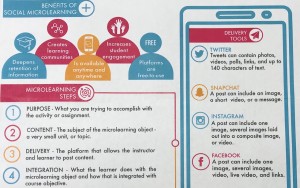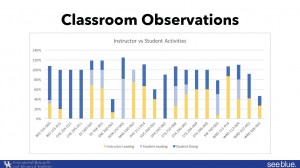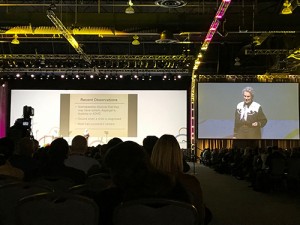I was recently lucky enough to attend the EDUCAUSE annual conference, through the UCISA bursary scheme, held in Philadelphia, PA at the start of the month. This is my second post reflecting on it, you can read part 1 here.

Day 2
The first session I attended on Thursday was “2017: The Year of the Active Learning Classroom” presented by D. Christopher Brooks and Malcolm Brown (EDUCAUSE), Melody Buckner (University of Arizona), Adam Finkelstein (McGill University) and Sehoya Cotner (University of Minnesota). Active Learning Classrooms (ALCs) were judged the top strategic technology for 2017 by Educause. ALCs, also referred to as ‘smart classrooms’ or ‘flexible classrooms’, are often student-centred, technology-rich learning environments that can support Active Learning pedagogy, which research has demonstrated can be a better pedagogy when compared to more passive forms of instruction. The This breakout session (in the Transforming the Student Experience track) explored what research about the impact of ALCs (for example the TEAL project at MIT and SCALE-UP) and the teaching practices that work best in them. They also covered the Learning Space Rating System (LSRS), a tool for assessing the strength of a classroom design to support active learning. Melody Buckner presented from the Instructional Design Perspective, using an Adobe Spark presentation which they used in classes. What came out of the session overall was that active learning gains by academics changing the teaching to fit the learning space, although changing the space itself isn’t enough alone. Some faculty members didn’t know how to teach in the new spaces, so support is needed to help with this.
Potential of learning spaces can only be realised if you have good teaching in them #EDU17
— Emma Fletcher (@emmfletcher) 2 November 2017
Sehoya Cotner spoke about her experiences of teaching biology in a traditional classroom versus an ALC. The expectations before this were that the students in traditional classrooms would be higher achievers. However they found that the students in ALC classrooms outperformed against their expected grades. The activities in the ALCs don’t need to be that sophisticated, for example using audience participation tools (such as clickers) or doing activities that are difficult to do in a traditional classroom.
Students in traditional classrooms achieved as expected whereas in the ALC they outperformed against their expectations. #EDU17 — Emma Fletcher (@emmfletcher) 2 November 2017
The general session for Thursday was “Decision Biases: Improving the Quality of our Everyday Decisions” from Katherine L Milkman, an expert in behavioural economics. The session she presented was about using choice architecture to influence decisions. We are often influenced by our environment (both physical and virtual) in the decisions we make, so this could be used to help us make “better” decisions. For example when visiting a cafeteria you are more likely to choose the things at the start when your tray is empty, so why not put the healthier options there. More people use the escalators rather than the stairs, can you make more people use the stairs if you make it fun.
The presentation had much in common with the nudge theory. Milkman gave six principles to improved decision making:
- Set helpful defaults – for example there are much higher organ donation rates in countries where you have to opt out rather than opt in, as it can make people feel like they are giving something up if they have to opt out.
- Prompt people to plan – people have a desire to keep commitments that they have made so asking “when do you plan to…” can increase the likelihood of someone doing the task.
- Leverage social norms – it can be uncomfortable not to participate when others are.
- Create accountability
- Capitalise on fresh starts – for example the number of people who make ‘New years resolutions’
- Allow pre-commitment
 The next session I attended was “Learning in Bursts: Microlearning with Social Media” delivered by Lindsey Sudbury and Clair Waterbury from Northeastern University. Microlearning, or just in time (JIT) learning, is about short-term learning activities which might involve short engagements several times a day. Whilst it can be done on social media it doesn’t have to be, however this session focused on social microlearning. Social media allows you to easily produce and consume information with people around you as well as virtually. 23% of Twitter users and 35% of Instagram users check the platform several times a day. One thing to bear in mind is that the platform you choose brings with it certain values. For example Facebook doesn’t allow anonymous accounts and you used to have to state a specific gender. They also spoke about using a hashtag for class, posting articles and reflections, which some staff at YSJ already do. This allows unstructured social learning to take place and extends the classroom, students may be more likely to read an article linked on Twitter than just reading an article.
The next session I attended was “Learning in Bursts: Microlearning with Social Media” delivered by Lindsey Sudbury and Clair Waterbury from Northeastern University. Microlearning, or just in time (JIT) learning, is about short-term learning activities which might involve short engagements several times a day. Whilst it can be done on social media it doesn’t have to be, however this session focused on social microlearning. Social media allows you to easily produce and consume information with people around you as well as virtually. 23% of Twitter users and 35% of Instagram users check the platform several times a day. One thing to bear in mind is that the platform you choose brings with it certain values. For example Facebook doesn’t allow anonymous accounts and you used to have to state a specific gender. They also spoke about using a hashtag for class, posting articles and reflections, which some staff at YSJ already do. This allows unstructured social learning to take place and extends the classroom, students may be more likely to read an article linked on Twitter than just reading an article.
The final breakout session of the day was “Perspectives on Video Creation to Enhance Student Learning: the Whys and Hows” presented by Kelly M. Dempsey & Sarah P. Kunze (Colgate University) and Nicholas Joseph Brazzi & Garrick Chow (LinkedIn Learning). With the current focus of the TEL team of working with academic staff to produce screencasts and video for students this session was a must attend for me. It was delivered by staff from Colgate University, who spoke about their own experiences, where they opened a centre in 2010 with support for faculties. This was where students were able to create videos, which may have been an alternate (rather than a written report) or supplementary assignment. Using video allowed them to illustrate what they have learnt to a broader audience. Whilst some students enjoyed the video creation some still preferred writing a paper. They found some students needed support to help them communicate visually, for example scaffolding steps. They also spoke about their use of digital lightboards by academic staff. They have had received positive feedback from students who have access to the videos, as they allow them to rewind and replay the content thereby reinforcing learning. The Lynda.com staff authors (as regular readers of the blog will know, we’re fans of Lynda here at TEL with our Learn with Lynda feature) offered advice and tips on creating video. They spoke about trying to make the videos sound more conversational and natural, although they script the videos they don’t want them to sound like they are being read out.
Last presentation of the day #EDU17 pic.twitter.com/T2qXvTv9Fv
— Emma Fletcher (@emmfletcher) 2 November 2017
Day 3
 The final day started with the breakout session presented by Virginia Lacefield, Enterprise Architect at University of Kentucky, “Evaluating the Impact of Technology-Enhanced Active Learning Classrooms on Student and Instructors: Lessons from our First Full Year”. This session was about the in-depth evaluation of 17 new technology-enhanced active learning (TEAL) spaces at the University of Kentucky (built between 2014-2016) which looked at their impact on instruction, student learning outcomes, and retention. The furniture layouts and technology options in the rooms were selected in partnership with primary users and the room capacity ranged from 21 to 132 seats. Over the 2016-17 academic year 9340 students (roughly 42%) took at least once class in the TEAL classrooms. They collected surveys from students and instructors as well as carrying out classroom observations and looking at course grades. The classroom observations were adapted from the University of Minnesota developed instrument and looked at what activities were taking place at regular intervals. The findings showed a real variation between classes, some staff weren’t using the TEAL classrooms as well as they could. Using the grades they found out of the 126 courses that had enough data points for comparison just 35 had significant grade differences (with 29 of these being positive differences favouring the TEAL section). However they did find that there was significant correlation between number of TEAL courses taken and 2nd year retention. As a result they are offering technology/pedagogy open houses and scheduled one-on-one support appointments. They will also examine courses with significant course grade differences for reasons for change.
The final day started with the breakout session presented by Virginia Lacefield, Enterprise Architect at University of Kentucky, “Evaluating the Impact of Technology-Enhanced Active Learning Classrooms on Student and Instructors: Lessons from our First Full Year”. This session was about the in-depth evaluation of 17 new technology-enhanced active learning (TEAL) spaces at the University of Kentucky (built between 2014-2016) which looked at their impact on instruction, student learning outcomes, and retention. The furniture layouts and technology options in the rooms were selected in partnership with primary users and the room capacity ranged from 21 to 132 seats. Over the 2016-17 academic year 9340 students (roughly 42%) took at least once class in the TEAL classrooms. They collected surveys from students and instructors as well as carrying out classroom observations and looking at course grades. The classroom observations were adapted from the University of Minnesota developed instrument and looked at what activities were taking place at regular intervals. The findings showed a real variation between classes, some staff weren’t using the TEAL classrooms as well as they could. Using the grades they found out of the 126 courses that had enough data points for comparison just 35 had significant grade differences (with 29 of these being positive differences favouring the TEAL section). However they did find that there was significant correlation between number of TEAL courses taken and 2nd year retention. As a result they are offering technology/pedagogy open houses and scheduled one-on-one support appointments. They will also examine courses with significant course grade differences for reasons for change.
The next session was “Changing the ‘Game’: Faculty Motivation and Teaching with Technology Innovation” presented by Mary Paul and Rudy J. Sanchez from California State University. This session looked at the how critical it is to engage faculty in driving innovation in teaching and learning with technology. They stated the importance of developing a culture of faculty driven innovation, rather than a top-down approach. For the staff to be committed involvement from the start is key. Quite often the fear of failure can be an inhibitor of this innovation, lack of confidence in technology adds to this. Typically it takes three years for faculty to feel confident with technology so this needs to be built in. An important message from the session was that it’s not about the technology it is about the pedagogy. It’s not about using technology for the sake of it, but looking how it can support and enhance the teaching taking place.
Innovation does not necessarily have to take time. Small steps can still be innovative #EDU17
— Emma Fletcher (@emmfletcher) 3 November 2017
The closing general session of the conference was “Developing Students who Have Different Kinds of Minds” delivered by Temple Grandin, a professor and author. She was talking about if some innovators from the past, such as Edison and Einstein (who she suggested would be diagnosed with autism or ADHD) were in today’s education system and how they may struggle. In her presentation she spoke about her own experiences and that of students she has taught. She had an unusual presentation style and the presentation was (at times) hard to follow, her message was slightly lost on me because of this. Whilst I agree that education at K12/secondary (having taught in one for over a decade) is becoming less creative and hands on, and not suited for all children I’m not sure a Higher Education technology conference is the best forum for this. I disagree that technology is bad, and that “computer games rot your brain”, which was a comment she made that stood out for me. I didn’t join the queue to buy her books (and receive her autograph) afterwards.

Overall I enjoyed the conference experience although it was, at times, overwhelming due to the sheer scale of it! I personally found the breakout sessions more engaging than the general sessions, and it was interesting to hear about American institutions. The conference hashtag (#EDU17) was full of reflections and discussions during the conference and is a good place to catch up.
Emma

0 responses on "EDUCAUSE Annual Conference #EDU17 Part 2"